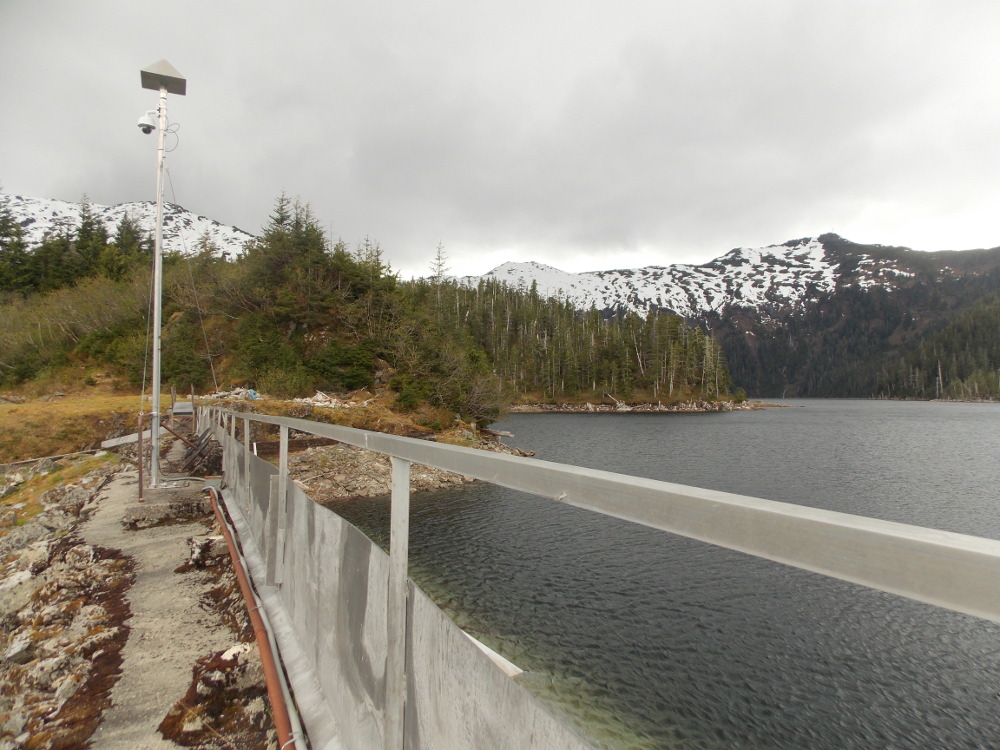
The dam on Crystal Lake holds water for the Blind Slough hydroelectric plant 1250 feet below. (Joe Viechnicki/KFSK)
A consultant hired by the Petersburg borough is recommending some quick fixes and some long term improvements for the borough’s hydroelectric power plant at Blind Slough 17 miles south of town. A draft report says the hydro plant is performing adequately but could be upgraded.
Audio PlayerThe condition assessment for the Blind Slough plant is being done by McMillen Jacobs Associates, an engineering and consulting firm. The borough’s utility director Karl Hagerman said the assessment started last spring and included inspections of the facility in the spring and summer.
“This is a pretty detailed effort to take a close look at all the facilities, all the components and the equipment and come up with a summary of what we need to make sure that that facility can operate well into the future reliably and provide power,” Hagerman said. “It historically provides about 25 percent of the power to the community, so it’s important to the department and to the community and we would like to see it continue to operate long into the future.”
The power plant is one of two sources for Petersburg’s hydroelectricity and cheaper than power purchased from the Southeast Alaska Power Agency. The dam at Crystal Lake and power plant near Blind Slough date back to 1924 although existing equipment was installed in the 1950s. A newspaper report from 1925 says the initial cost of the project was 115-thousand dollars. Hagerman says one of the generators at the site is 1920s vintage but doesn’t get used very much. The main generator dates to the 1950s.
The assessment recommends three fixes in the urgent category because they could pose a danger to employees of the electric utility. Hagerman explained one problem noted was potential exposure to electrocution at the powerhouse.
“There’s a cage that houses for employer protection some connections from the generator that they felt the cage wasn’t quite good enough,” he said. “They would like to see some more shielding. It’s basically a mesh cage and they want a solid cage around these connections. There’s a arc-flash hazard and you know it’s been like that since the 1950s so obviously there have not been any problems at the site but the potential is there. So that’s an easy fix and the department will take care of that in the near future.”
Other recommended urgent fixes are tests of some of the components to make sure they are working properly. That includes a valve that can be used for bypassing water away from the power plant.
Those are recommendations in the short term. But the report also looks at longer term replacement and improvement of some of the parts of the facility.
Hagerman said he was surprised by the consultant’s focus on replacing the penstock. That’s the pipeline where water is dropped 1200 feet down from the lake and into the generator.
“The pipeline is, it’s a steel pipe that is, not in terrible shape I didn’t think but they found that by up-sizing the pipe we can reduce head-loss in the pipe and potentially produce more power with the same amount of water we’re using now,” Hagerman said. “So that’s interesting to me. Anytime you can use the same resources and produce more power probably deserves a closer look.”
Head-loss is the energy lost because of friction in the pipeline. The consultant is also looking into replacing the turbine and generator and possibly increasing storage capacity in the reservoir. There are no dollar amounts yet connected to these recommendations but the consultant will be completing a final assessment with a capital improvement plan this winter.
“Nothing needs to be replaced tomorrow to continue to operate,” Hagerman said of the report’s findings. “There are numerous things that should be done to help us out, failing components, older equipment, within the next 3-5 years but there are quite items that they’re recommending be done in 7-8 years. So we do have some time. The facility is definitely not failing overall and we have time to plan a really good project or projects and move forward with some improvements out there.”
The electric utility has cash reserves to cover the cost of some work. Some of the capital projects being studied could carry big price tags, but Hagerman says he’s pretty confident the utility will be able to make some improvements without requiring a raise in electric rates.
In a related note, the water level at the reservoir has improved slightly with rainfall this month but still has a long way to go before its completely refilled. With a dry summer the utility got close to having to shut down the Blind Slough plant earlier this fall.










